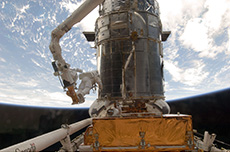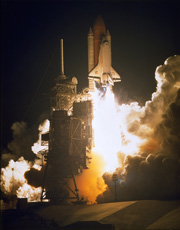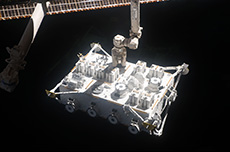Q. You used to be an aircraft engineer, but now you’re a robotic arm specialist. Describe the Space Shuttle from an engineer’s point of view.

Fifth repair mission on the Hubble Space Telescope, May 2005 (STS-125) (courtesy: NASA)
The Space Shuttle is a highly versatile and reusable space-launch system. Its unique capabilities served in a great variety of missions, including the many space experiments conducted in Spacelab [a reusable space laboratory which was housed in the Space Shuttle’s cargo bay]. NASA used the Shuttle to perform five maintenance flights on the Hubble Space Telescope – all of which involved challenging spacewalks. Without the servicing missions, we would not have been able to extend the telescope’s life, which is now more than 21 years and counting. Without a doubt, the Space Shuttle created an age of human space exploration sending as many as 355 people to low earth orbit, and I do not think we will see another spacecraft with such diverse capabilities for a while.
The Space Shuttle is a reusable launch vehicle made up of the Orbiter, the external fuel tank, and the solid rocket boosters. If we compare it to the capsules used on the Soyuz and Apollo missions, which only carry people and have extended safe abort capabilities, there are additional operational risks. Passengers in a capsule spacecraft can safely abort during most launch and re-entry stages, but the Space Shuttle’s design allows astronauts to safely bail out of the Orbiter in only certain flight phases such as in a steady horizontal flight in the atmosphere.
There were different design concepts in the initial Space Shuttle development, such as creating a space transportation system without using solid rockets and thus making a completely reusable vehicle using liquid fuel rocket boosters. However, due to the technology readiness level of the candidate concepts as well as the development funding situation in the US when the Shuttle was being developed in the 1970s, NASA settled on using the powerful thrust of the solid rocket boosters and the highly sophisticated liquid-fueled Space Shuttle Main Engines. Although the Space Shuttle had exceptional capabilities that no other space transportation system ever had, I think it was a daunting task, even for the United States, a global leader in human space exploration, to develop a reusable launch system that would adequately address safety and economic requirements.
Q. What are your lasting impressions from your three space flights?

January 1996 Space Shuttle launch, Wakata’s first space flight (courtesy: NASA)
There are many, but one of my most lasting impressions is from my first flight in 1996. I could not really fathom what it would be like to go into space until I actually did it. It was dark at launch time, just past 4:00 a.m., and when I looked out the overhead window on the flight deck as the Shuttle left the launch pad, it was almost like daytime because the flames from the main engines lit up the launch pad. Then, about four or five minutes after liftoff, I saw something very bright, like lightning, flashing outside the window. I had never seen nor heard about this kind of light, so I wondered, “What’s that?!” Later, after the main engine cutoff, the Crew Commander, Brian Duffy, told me that the thinner air in the upper atmosphere causes the flames from the main engines to wrap around the front of the Shuttle and that from the inside, this looks like flashing light.
During the powered ascent, I also saw some thin shards of ice outside the window along with the light from the flames. Sometimes in a movie, you see a piece of glass break in slow motion. It looked just like that, with pieces of ice, both large and small, floating outside of the Space Shuttle and sticking with it as if in a formation flight. It was a very cold January morning when we launched. The ice had stuck to the external fuel tank prior to liftoff and was now falling off as we ascended. The ice fragments looked just like shining gems, and I had the impression that the Space Shuttle was shooting through the flashing light from the main engine’s flames together with a bunch of jewels.
However, it was this kind of ice coming off the Shuttle during launch that could cause a terrible accident, which most people could not have predicted. The foam insulation that fell off the external fuel tank in the 2003 Columbia disaster destroyed the thermal protection material on the leading edge of the Space Shuttle’s left wing. When I recall the large ice pieces brightly illuminated by the plume of the main engines, which I saw through the overhead window in the cockpit on my first flight, I get the feeling that we could have had that kind of accident, too. In that sense, the sight of that light is seared into my memory.


